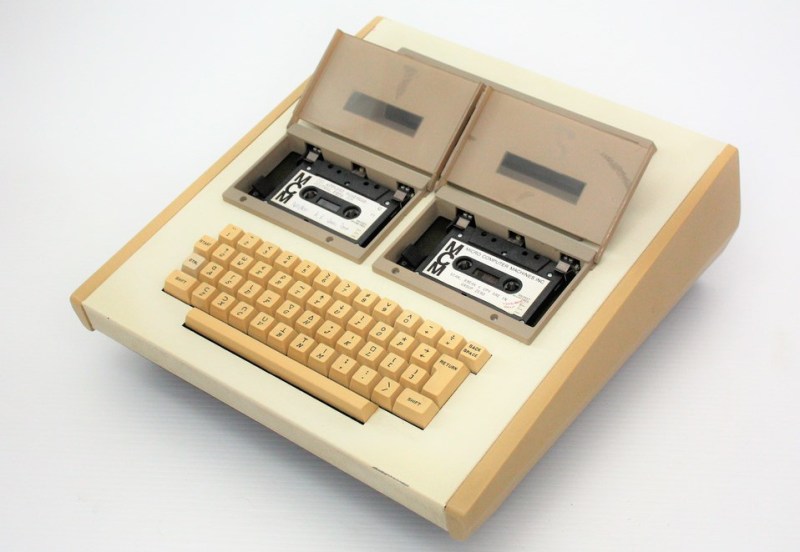
Not to start a debate in the comments or anything, but what would you say was the first microcomputer, or personal computer? We suppose the answer depends on your definition. Some would argue that the PC was born at Xerox PARC with a curious portrait-mode display and a three-button mouse, while others would say it all began in a garage in either Los Altos, California or Albuquerque, New Mexico.
If you take the term ‘computer’ to mean that which can crunch big numbers fairly quickly, then the Canadian-made MCM/70 is arguably the first personal computer in that it is portable, has an alphanumeric keyboard, a display, and supports cassette storage, which could be used to extend the 8K of memory. It was an all-in-one computing solution, and it could have an optional telephone modem built in. This was a forward-thinking machine for 1974.
A General-Purpose Personal Computer
We’re all used to personal computers as the norm, be they mobile, laptop, or desktop. But of course, in the early days, computers were large single-purpose machines used to crunch even bigger numbers. Go back even further in time, and the computers are humans operating fancy electromechanical calculators at high speeds, or, simply using pencils or chalk.
Before the personal computer arrived, people had to share time on mainframe machines to do their computing. Imagine having to go down to the library every time you wanted to look something up on the Internet. Wouldn’t you much rather do it at home on your own machine? Of course you would.

In the late 1960s, professor Mers Kutt of Queen’s University in Kingston, Ontario was tired of watching the efficiency of mainframe computer users be hampered by the long wait times involved in submitting programs. Kutt started a company in 1968 and built a data entry terminal with a one-line display that eradicated the need for punching cards.
Kutt wanted to build a different machine to support development of APL, a new programming language full of math symbols that was best programmed on a custom keyboard. He began a new company, Micro Computer Machines (MCM) to build the devices, which look like primitive cyberdecks that weighed 20 pounds.
A Luggable, Math-Minded Cyberdeck
The MCM/70 was designed to be an affordable, general purpose computer, if you consider $9,800 for the fully-equipped model in 1974 “affordable”. It’s based on the 800 KHz Intel 8008 and is one of the first commercial computers to use the CPU. The display was a 32-character glass plasma number that supported scrolling.

These machines came a couple of different ways: they either had no cassette decks at all, one cassette deck and one acoustic coupler for uploading programs to other machines, or two cassette decks. There was an APL interpreter built into the ROM, and a battery to save the workspace when powered down. They could even be rigged to run on battery power.
The MCM/70 had a specialized keyboard with QWERTY and APL legends, ISO Enter, and a honkin’ 9u space bar. Like any vintage computer, we’d love a crack at clacking on it. Be sure to check out all the pictures on this Vintage Computers of Canada site.
Of course, this type of computing power did not come cheap, and wouldn’t have typically been found in the average consumer’s home, which is arguably how many people might describe the personal computer. These minicomputers and their successors were mostly sold to companies and government institutions that needed to make big calculations. Various hospitals and insurance companies along with NASA and the US Army were a few of MCM’s customers, and they sold hundreds of units within a handful of years.
So What Happened?
It may have been a problem of passion. The book Inventing the PC: the MCM/70 Story alleges that Mers Kutt was neither a hacker nor a hobbyist; he was instead an entrepreneur and inventor who simply saw a market and found a partner to help him realize his vision. Nevertheless, he persisted.
According to Inventing the PC, there was a ‘devastating power struggle’ between Kutt and some of MCM’s investors. By the late 1970s, they began to see competitors offering the same amount of computing power, and MCM were designing an improved machine in response. As the story goes, they didn’t have the funding to fuel the rapid development required to beat the competition to market. By 1983, MCM was out of business.
Kutt started one final company called All Computers, Inc. and ended up suing Intel, alleging that they used his patented circuitry inside Intel processors. The suit was dismissed in 2005, and Kutt was inducted into the Order of Canada in 2006.
Inputs of Interest: Canadian MCM/70 Was Kinda Like the First Cyberdeck
Source: Manila Flash Report
0 Comments